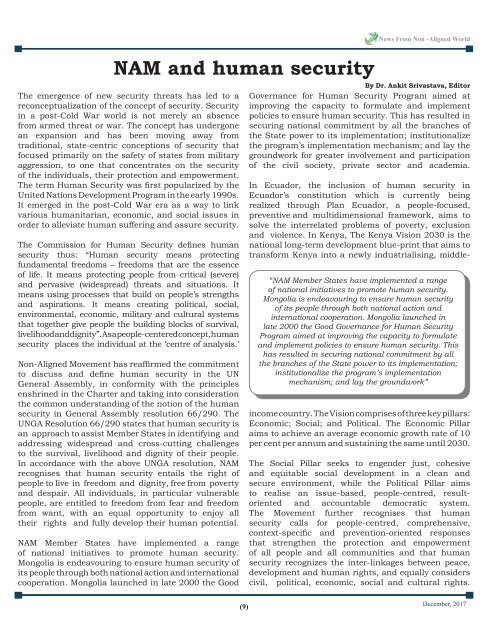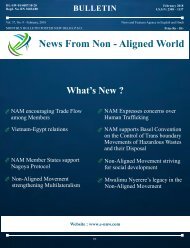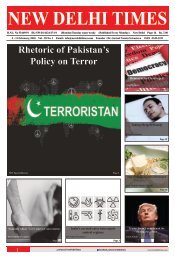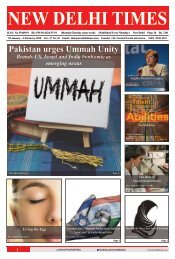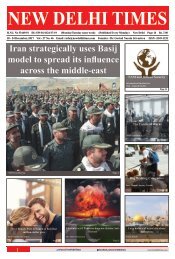Create successful ePaper yourself
Turn your PDF publications into a flip-book with our unique Google optimized e-Paper software.
NAM and human security<br />
The emergence of new security threats has led to a<br />
reconceptualization of the concept of security. Security<br />
in a post-Cold War world is not merely an absence<br />
from armed threat or war. The concept has undergone<br />
an expansion and has been moving away from<br />
traditional, state-centric conceptions of security that<br />
focused primarily on the safety of states from military<br />
aggression, to one that concentrates on the security<br />
of the individuals, their protection and empowerment.<br />
The term Human Security was first popularized by the<br />
United Nations Development Program in the early 1990s.<br />
It emerged in the post-Cold War era as a way to link<br />
various humanitarian, economic, and social issues in<br />
order to alleviate human suffering and assure security.<br />
The Commission for Human Security defines human<br />
security thus: “Human security means protecting<br />
fundamental freedoms – freedoms that are the essence<br />
of life. It means protecting people from critical (severe)<br />
and pervasive (widespread) threats and situations. It<br />
means using processes that build on people’s strengths<br />
and aspirations. It means creating political, social,<br />
environmental, economic, military and cultural systems<br />
that together give people the building blocks of survival,<br />
livelihood and dignity”. As a people-centered concept, human<br />
security places the individual at the ‘centre of analysis.’<br />
Non-Aligned Movement has reaffirmed the commitment<br />
to discuss and define human security in the UN<br />
General Assembly, in conformity with the principles<br />
enshrined in the Charter and taking into consideration<br />
the common understanding of the notion of the human<br />
security in General Assembly resolution 66/290. The<br />
UNGA Resolution 66/290 states that human security is<br />
an approach to assist Member States in identifying and<br />
addressing widespread and cross-cutting challenges<br />
to the survival, livelihood and dignity of their people.<br />
In accordance with the above UNGA resolution, NAM<br />
recognises that human security entails the right of<br />
people to live in freedom and dignity, free from poverty<br />
and despair. All individuals, in particular vulnerable<br />
people, are entitled to freedom from fear and freedom<br />
from want, with an equal opportunity to enjoy all<br />
their rights and fully develop their human potential.<br />
NAM Member States have implemented a range<br />
of national initiatives to promote human security.<br />
Mongolia is endeavouring to ensure human security of<br />
its people through both national action and international<br />
cooperation. Mongolia launched in late 2000 the Good<br />
News From Non -Aligned World<br />
By Dr. Ankit Srivastava, Editor<br />
Governance for Human Security Program aimed at<br />
improving the capacity to formulate and implement<br />
policies to ensure human security. This has resulted in<br />
securing national commitment by all the branches of<br />
the State power to its implementation; institutionalize<br />
the program’s implementation mechanism; and lay the<br />
groundwork for greater involvement and participation<br />
of the civil society, private sector and academia.<br />
“NAM Member States have implemented a range<br />
of national initiatives to promote human security.<br />
Mongolia is endeavouring to ensure human security<br />
of its people through both national action and<br />
international cooperation. Mongolia launched in<br />
late 2000 the Good Governance for Human Security<br />
Program aimed at improving the capacity to formulate<br />
and implement policies to ensure human security. This<br />
has resulted in securing national commitment by all<br />
the branches of the State power to its implementation;<br />
institutionalize the program’s implementation<br />
mechanism; and lay the groundwork”<br />
In Ecuador, the inclusion of human security in<br />
Ecuador’s constitution which is currently being<br />
realized through Plan Ecuador, a people-focused,<br />
preventive and multidimensional framework, aims to<br />
solve the interrelated problems of poverty, exclusion<br />
and violence. In Kenya, The Kenya Vision 2030 is the<br />
national long-term development blue-print that aims to<br />
transform Kenya into a newly industrialising, middleincome<br />
country. The Vision comprises of three key pillars:<br />
Economic; Social; and Political. The Economic Pillar<br />
aims to achieve an average economic growth rate of <strong>10</strong><br />
per cent per annum and sustaining the same until 2030.<br />
The Social Pillar seeks to engender just, cohesive<br />
and equitable social development in a clean and<br />
secure environment, while the Political Pillar aims<br />
to realise an issue-based, people-centred, resultoriented<br />
and accountable democratic system.<br />
The Movement further recognises that human<br />
security calls for people-centred, comprehensive,<br />
context-specific and prevention-oriented responses<br />
that strengthen the protection and empowerment<br />
of all people and all communities and that human<br />
security recognizes the inter-linkages between peace,<br />
development and human rights, and equally considers<br />
civil, political, economic, social and cultural rights.<br />
(9)<br />
December, <strong>2017</strong>


